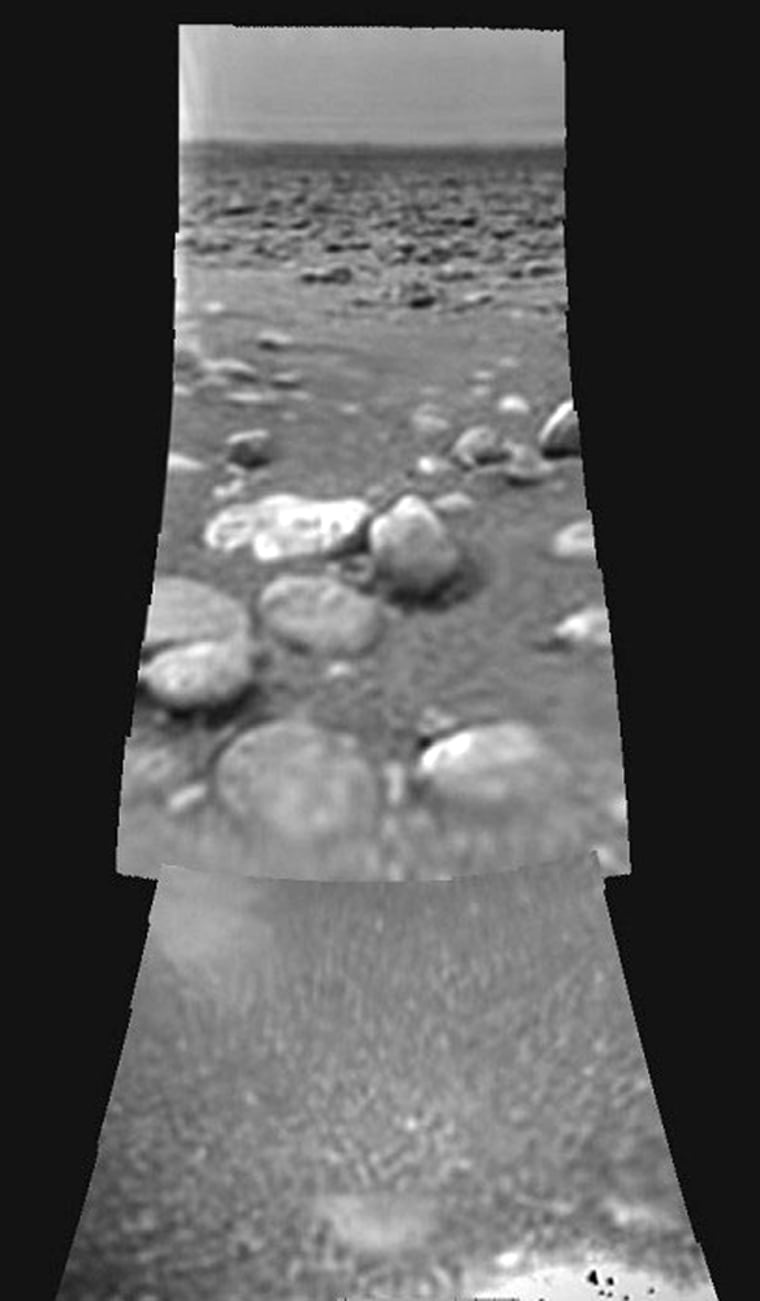Saturn’s planet-size moon Titan has dramatic weather, with turbulent high-altitude winds, periodic floods of liquid methane and possibly lightning, scientists said Wednesday in describing a world that may look like Earth before life developed.
The European Space Agency’s probe landed on Titan in January, uncovering some mysteries of the methane-rich globe — the only moon in the solar system known to have a thick atmosphere. Scientists presented detailed results of months of study in the online edition of the journal Nature and at a news conference in Paris.
“It’s a very strange fantasy world made of ice, with things like gasoline and tar that make up the rivers and the lake beds,” said scientist Jonathan Lunine of the University of Arizona, when asked how he would explain the finding to a child.
“If you try to walk around on it, your feet might get stuck in some places, you’d slide down into methane rivers in other places, and you’d better watch out for the ammonia volcanoes,” he said. “And absolutely bring a big heavy coat, because it’s really cold — and bring a tank of oxygen because there’s no oxygen to breathe, but don’t light a match.”
Titan, located 740 million miles (1.2 billion kilometers) from Earth, has long intrigued researchers because it is surrounded by a thick blanket of nitrogen and methane. Until recently, scientists believed the most likely explanation for the methane was the presence of a methane-rich sea of hydrocarbons.
The Huygens probe and its mother ship, Cassini, have offered evidence against that theory. The $3.3 billion Cassini-Huygens mission to explore Saturn and its moons was launched in 1997 from Cape Canaveral, a joint effort involving NASA, ESA and the Italian space agency.
Titan’s clouds are made from molecules that include carbon and nitrogen — compounds generated in photochemical smog and circulated by rain and the atmosphere, the researchers reported in Nature.

They said there was no reason to believe Titan’s methane is a product of biological activity.
Yet more methane is appearing constantly and may burst from ice volcanoes or fall as rain, researchers said, describing riverbed and drainage channels spotted during the craft’s descent Jan. 14.
Titan’s upper atmosphere is turbulent, with winds blowing mostly in the direction of its rotation, then slowing down and changing direction closer to the surface. Electric charges detected in the atmosphere could be lightning, Lunine said.
The first results from the Huygens probe were released in January: Black-and-white photos showed a rugged terrain of ridges, peaks, veinlike channels and apparently dry lakebeds.
Scientists have been surprised by a mystery component they cannot identify.
“It’s a world, an atmosphere, a surface that is very dynamic, and perhaps as it seems there is volcanic activity, the interior of Titan is also no doubt very dynamic,” said Jean-Pierre Lebreton, Huygens mission scientist.
Titan’s smoggy atmosphere may be similar to that of the primordial Earth, and scientists believe that studying it could provide clues to how life began.
Titan shows signs of having “the very first stages of the building blocks of life,” but it’s too cold for the process to progress, said John Zarnecki, a scientist from Open University in Britain. Temperatures on the surface are 290 degrees below zero Fahrenheit (-180 degrees Celsius).
If the sun one day expands and becomes a red giant, as some speculate, Titan may warm up, Zarnecki said.
“Maybe in 4 billion years’ time, at the end of the sun’s life, maybe Titan will be the new Earth,” he said.
